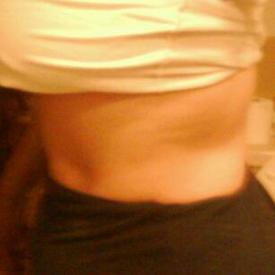Calling people who squat heavy...
Replies
-
I've been squatting for years and I can't get anywhere near parallel with a barbell. I have read it's to do with the ratio of femur length to torso length. It means some people can't go low without becoming imbalanced or leaning forward excessively. I just use dumbells or a smith machine. Have you tried front squats/hack squats?
I looked this up earlier today as I have relatively long femurs compared to shin length, in relation to the fact that I can't do pistol squats without falling backwards unless I lean so far forwards on my knees that they hurt. I have very good balance generally and not too bad joint flexibility and can go ATG on regular squats, so it doesn't seem logical that I can't do pistol squats. But apparently femur length is the issue.
Here is an article I found about it: http://voices.yahoo.com/long-femurs-why-wide-stance-makes-parallel-squats-11752392.html?cat=50 I have exactly the problems described, i.e. leaning too far forward (which also hurts my knees) when squatting in a shoulder width apart stance, falling backwards if I go too low. When attempting parallel squats with a shoulder width apart stance, my torso is almost parallel to the floor in order to maintain balance (as described in the article), and I can't go lower without holding my arms out in front of me, I can just about maintain my balance if my arms are straight out in front of me as a counterbalance, but if my hands are in barbell holding position, I fall backwards. I've always wondered if this was a body proportion thing, and yes, it seems to be the case.
However, a wider stance prevents all of this, which is what the article says to do, in fact I naturally have always squatted in the stance mentioned in the article and never had problems going ATG including with a barbell, and never considered it an issue as I never saw any reason to try to barbell squat with a narrower stance. It's only due to the issue with pistol squats that I even looked this up, and if anyone has any ideas about how I can do one legged ATG squats without falling backwards I'd be delighted to hear it because my barbell loaded with all the weights I have is only 88lb, and last workout I squatted 84.4lb for 6 reps.
Actually, most strength coaches AND all physical therapists I have talked to, say that inability to do pistol squats and get A2G has more to do with lack of ankle mobility. That's why you see peeps put plates under their heels and Oly shoes have a tiny heel. Squatting is dependent on the joints from the TOP to the BOTTOM. Shoulders, hips, knees and ankles. If long femurs are the problem, then working on your dorsiflexion CAN help.
OP- you need mobility. Anybody who can't get A2G-- you need mobility. We are made to squat. It is a basic body movement.
When I started, my squat was FREAKING UGLY. I have worked on mobility for over a year and it's way better, even under heavy loads. It takes time and dedication. Work on hips! Hips! Hips! Hips! It will also protect your knees, (helps you push your knees out at the bottom of the squat) and lower back.0 -
Great tips!
I'm the only one at my gym that uses the squat rack, so I'm always second-guessing my form0 -
No one can help your squat form without seeing you perform the squat. Suprised no one asked for a video in 2 pages.0
-
When I started, I couldn't do a body weight quarter squat, and forget about parallel. I can now successfully do 120lb back squat to parallel. But it took time - a lot of time.
Here are some things that helped me:
- Widening my stance. I am very large (~300lbs at the time), and I was trying to squat like the people who weigh 120lbs. I don't, and I am not going to have the same form as them. Go wider on your stance. It's okay.
- Doing full body weight squats to the ground (@ss to the grass as they say) holding on to something to get there to help with hip mobility issues. Stay there and just sit in that position for a while. You will feel it if you have hip mobility issues.
- Squat to Stands for mobility
- Goblet Squats to a bench
- Blanks to help build core strength0 -
Great tips!
I'm the only one at my gym that uses the squat rack, so I'm always second-guessing my form
I wish I was the only one at my gym using the squat rack.0 -
I've been squatting for years and I can't get anywhere near parallel with a barbell. I have read it's to do with the ratio of femur length to torso length. It means some people can't go low without becoming imbalanced or leaning forward excessively. I just use dumbells or a smith machine. Have you tried front squats/hack squats?
I looked this up earlier today as I have relatively long femurs compared to shin length, in relation to the fact that I can't do pistol squats without falling backwards unless I lean so far forwards on my knees that they hurt. I have very good balance generally and not too bad joint flexibility and can go ATG on regular squats, so it doesn't seem logical that I can't do pistol squats. But apparently femur length is the issue.
Here is an article I found about it: http://voices.yahoo.com/long-femurs-why-wide-stance-makes-parallel-squats-11752392.html?cat=50 I have exactly the problems described, i.e. leaning too far forward (which also hurts my knees) when squatting in a shoulder width apart stance, falling backwards if I go too low. When attempting parallel squats with a shoulder width apart stance, my torso is almost parallel to the floor in order to maintain balance (as described in the article), and I can't go lower without holding my arms out in front of me, I can just about maintain my balance if my arms are straight out in front of me as a counterbalance, but if my hands are in barbell holding position, I fall backwards. I've always wondered if this was a body proportion thing, and yes, it seems to be the case.
However, a wider stance prevents all of this, which is what the article says to do, in fact I naturally have always squatted in the stance mentioned in the article and never had problems going ATG including with a barbell, and never considered it an issue as I never saw any reason to try to barbell squat with a narrower stance. It's only due to the issue with pistol squats that I even looked this up, and if anyone has any ideas about how I can do one legged ATG squats without falling backwards I'd be delighted to hear it because my barbell loaded with all the weights I have is only 88lb, and last workout I squatted 84.4lb for 6 reps.
Actually, most strength coaches AND all physical therapists I have talked to, say that inability to do pistol squats and get A2G has more to do with lack of ankle mobility. That's why you see peeps put plates under their heels and Oly shoes have a tiny heel. Squatting is dependent on the joints from the TOP to the BOTTOM. Shoulders, hips, knees and ankles. If long femurs are the problem, then working on your dorsiflexion CAN help.
I just tried this with the Times Atlas of History under my heels.... and bingo! I can do pistol squats (they're easy, in fact!) and narrow stance front squats, both ATG. Thank you for that tip :flowerforyou:
I'm not convinced that I have a problem with ankle flexibility though, because I have pretty good flexibility including in my ankle, I can do full range calf raises with my toes on a platform, and get really low with those (i.e. heel well below my toes). Putting the book under my feet is no different in mechanical terms to making my shins a couple of inches longer. Trying to force my ankle to overflex in order to compensate for relatively shorter shins doesn't seem like a good idea, and trying to do this when squatting hurts my knees (I tried this in the past and stopped because it hurt my knees). In any case, the book seems to have fixed this issue so I'll continue with that.
There is quite a lot of variation between humans in terms of tibia/femur ratio, I know that from studying anthropology, and it varies in different populations and has enough biomechanical implications for natural selection to favour certain ratios in certain environments (shorter tibia/longer femur is believed to be an adaptation to walking/running in hilly/mountainous terrain, while longer tibia/shorter femur is better for running on level terrain - interesting because my husband has relatively longer shins and can out-run me on the flat, but I can beat him running up stairs). Given that, I don't think it's far fetched to suggest that this kind of thing can affect the mechanics and form of various lifts.0 -
when i first started i had a mental block where i couldnt get myself to go lower (even though i physically could). Finally I took out my phone and started videoing myself doing it...that's when i realized just how much lower i should be going. try videoing yourself so you can actually see yourself do the lift.0
-
Very interesting, I'll try putting something under my heel.
I have tried doing mega wide squats too and I just can't get my *kitten* down. I don't think it's a matter of mobility or form there's just a natural imbalance in the dimensions of my body. If you could see me attempt a squat you'd understand, it's pretty comical.
Thanks for the tips.0 -
second box squats as well as mobility work!
This rehabbed my squat so I finally quit hurting my back and can progress loading the bar.0 -
Just bumping to save videos and info...0
-
Make sure you are sticking your butt back far enough. My old lifting partner thought he couldn't go parallel but once he started trying to sit "back" instead of down he could. Yeah, try it with a box first. Also, if you have a spotter you might try it with a barbell, it might help you push down farther (make sure you are warmed up first).0
-
second box squats as well as mobility work!
This rehabbed my squat so I finally quit hurting my back and can progress loading the bar.
I agree.
I've used box squats to teach a few lifting partners how to squat properly and to work on their depth. You can squat to a slightly lower box each week0 -
I can't hit parallel without 315+ on my back. One trick is to sit back further and spread your knees wider. This will also help you to incorporate more glute/hamstring into your squat and reduce the range of motion a bit by minimizing forward knee travel.0
-
i've squatted heavy, and i've squatted bellow parrallel, but i've never squated heavy and gone bellow parrallel.
People actually do this? when i go as low as i can i really lighten the load and my lowest rep set will be 8-10.
IDK, just going as heavy as you can and going that deep into the knee joint seems... problematic.
I swear to god it seemed to be the prevailing school of thought when i was growing up that squatting bellow parralell was dangerous0 -
I swear to god it seemed to be the prevailing school of thought when i was growing up that squatting bellow parralell was dangerous
Probably. And we're out to correct that misinformation.
Squatting above parallel is dangerous.0 -
I swear to god it seemed to be the prevailing school of thought when i was growing up that squatting bellow parralell was dangerous
Probably. And we're out to correct that misinformation.
Squatting above parallel is dangerous.
It's not dangerous, it's just not as effective as going below parallel. I spent a lot of time doing high box squats with heavy weight (for me- often in the mid to upper 600's) and never had any problems. My squat workout at the time was doing full squats, then high box with +50lbs over my full squat work weight, and then deep pause squats (where you hold everything tight at the bottom position for a 3 count and explode up) with -50 of my full squat work weight for that session.0 -
I swear to god it seemed to be the prevailing school of thought when i was growing up that squatting bellow parralell was dangerous
Probably. And we're out to correct that misinformation.
Squatting above parallel is dangerous.
It's not dangerous, it's just not as effective as going below parallel. I spent a lot of time doing high box squats with heavy weight (for me- often in the mid to upper 600's) and never had any problems. My squat workout at the time was doing full squats, then high box with +50lbs over my full squat work weight, and then deep pause squats (where you hold everything tight at the bottom position for a 3 count and explode up) with -50 of my full squat work weight for that session.
It can be dangerous because it fails to engage the hamstrings. This can create an imbalance and really mess with your knees. It's where "squats are bad for the knees" came from. Many people squat without going full depth and never experience any problems. Just like many people go on VLCD's and do ok, and smoke cigarettes until they're 90 and don't die of lung cancer. It's still best to follow best practices and err on the side of caution.0 -
Bump to read latter.0
-
"People only have to look at your quads to check your credibility.
 "
"
[/quote]
If that's the case, I may never have credibility. Last time I had 'definition' it was just a line. (that only I could see.)0 -
Google's pistol squats.......
Oh those are sooo hard!
I had seen/heard of those before, but I definitely can't do them.
check this out: http://www.youtube.com/watch?v=TWvIu7s-vIM 0
http://www.youtube.com/watch?v=TWvIu7s-vIM 0 -
No one can help your squat form without seeing you perform the squat. Suprised no one asked for a video in 2 pages.
True0 -
bump0
-
This is correct. I didn't even think about that!No one can help your squat form without seeing you perform the squat. Suprised no one asked for a video in 2 pages.
True0 -
People actually do this?
IDK, just going as heavy as you can and going that deep into the knee joint seems... problematic.
I swear to god it seemed to be the prevailing school of thought when i was growing up that squatting bellow parralell was dangerous
Actually going below parallel until you feel the "bounce" in the hole is what transfers the load OUT of the knee joint and into a hip-dominant exercise. If you are stopping above parallel, you are using your knees to reverse the downward motion of the bar before your glutes, hammies, and adductors are really involved fully in the activity, putting more strain on the joint and involving less overall muscle mass in the movement.0 -
People actually do this?
IDK, just going as heavy as you can and going that deep into the knee joint seems... problematic.
I swear to god it seemed to be the prevailing school of thought when i was growing up that squatting bellow parralell was dangerous
lol
no0 -
This is correct. I didn't even think about that!No one can help your squat form without seeing you perform the squat. Suprised no one asked for a video in 2 pages.
True
Me neither. I'm glad someone stated what should have been the obvious hah0 -
People actually do this?
IDK, just going as heavy as you can and going that deep into the knee joint seems... problematic.
I swear to god it seemed to be the prevailing school of thought when i was growing up that squatting bellow parralell was dangerous
Actually going below parallel until you feel the "bounce" in the hole is what transfers the load OUT of the knee joint and into a hip-dominant exercise. If you are stopping above parallel, you are using your knees to reverse the downward motion of the bar before your glutes, hammies, and adductors are really involved fully in the activity, putting more strain on the joint and involving less overall muscle mass in the movement.
i can certainly feel my *kitten* engaging more when i go below parallel, just seems like its stressing things in the knee joint more. but perhaps its all in a good way.
I guess i'm just thinking of the weight that i used to squat and only approached parallel. if i tried to squat that deep i feel as though i would have a good chance of hurting myself.0 -
People actually do this?
IDK, just going as heavy as you can and going that deep into the knee joint seems... problematic.
I swear to god it seemed to be the prevailing school of thought when i was growing up that squatting bellow parralell was dangerous
Actually going below parallel until you feel the "bounce" in the hole is what transfers the load OUT of the knee joint and into a hip-dominant exercise. If you are stopping above parallel, you are using your knees to reverse the downward motion of the bar before your glutes, hammies, and adductors are really involved fully in the activity, putting more strain on the joint and involving less overall muscle mass in the movement.
i can certainly feel my *kitten* engaging more when i go below parallel, just seems like its stressing things in the knee joint more. but perhaps its all in a good way.
I guess i'm just thinking of the weight that i used to squat and only approached parallel. if i tried to squat that deep i feel as though i would have a good chance of hurting myself.
That's possibly true because your max capacity on a partial squat is going to be less than on a full squat, one is an easier lift than the other.
When I think it about this question it always makes me think about olympic lifting. In both C&J and snatch you are not only taking a heavy load well below parallel, you're actually catching it there. Surely that would create the most insane impact on knees, but they seem to handle it.0 -
I didn't read through all of the replies, but I can tell you about my experience with squats.
One year ago I started a strength training program which involved barbell exercises 3 days/week. The goal was to add five pounds of weight each session. Squats were a major part of the program and all three training days required starting with the squat.
I had a LOT of trouble getting the movement down. Eventually I hurt my lower-back when I leaned too far forward with 200 lbs on my shoulders, a week off seemed to fix that. I dropped the weight down to the bar and started over. This happened several times - as soon as I neared about 200 lbs, my form would go to hell and i'd start to feel it in my back. By this time I was smart enough to stop before I actually hurt my back again.
What seemed to help me was getting flexibility in the hips and hamstrings. I started doing hip flexor stretches at least three times/day. I also would do body weight squats but would hold the bottom portion of the exercise when I reached just below parallel. One other thing - I would point my toes upward when doing squats, this ensured that I was on my heels which also seemed to help.
After I did the above suddenly my squat weight ballooned upward and I stopped hurting. I was flexible enough that trainers in the gym would compliment me on how deep I could go. My back also stopped hurting.
So try stretching more. Once my squatting went up, all of my other lifts went up as well.0 -
Given my tight hamstrings and hips flexors, I started stretching before workouts, primarily those 2 muscle groups if I knew I was doing squats. I've also heard the term of "sticking your butt out like a porn star" which kept the straight back in mind. Having my knees go *slightly* over my toes was apparently acceptable, which helped to make them much more easier.
I used to have a problem with feeling I was falling backwards, so I was able to have a slightly wider gap in my stance to help with the midsection bulk. I felt as though I "grounded" myself a little more, rather than the bulk of the weight feeling like it was pulling me back.0
This discussion has been closed.
Categories
- All Categories
- 1.4M Health, Wellness and Goals
- 398.2K Introduce Yourself
- 44.7K Getting Started
- 261K Health and Weight Loss
- 176.4K Food and Nutrition
- 47.7K Recipes
- 233K Fitness and Exercise
- 462 Sleep, Mindfulness and Overall Wellness
- 6.5K Goal: Maintaining Weight
- 8.7K Goal: Gaining Weight and Body Building
- 153.5K Motivation and Support
- 8.4K Challenges
- 1.4K Debate Club
- 96.5K Chit-Chat
- 2.6K Fun and Games
- 4.8K MyFitnessPal Information
- 12 News and Announcements
- 21 MyFitnessPal Academy
- 1.5K Feature Suggestions and Ideas
- 3.2K MyFitnessPal Tech Support Questions





















